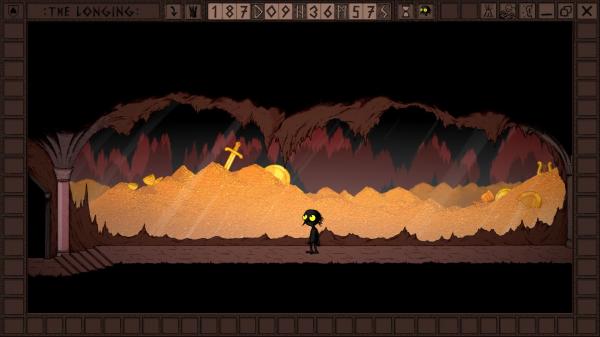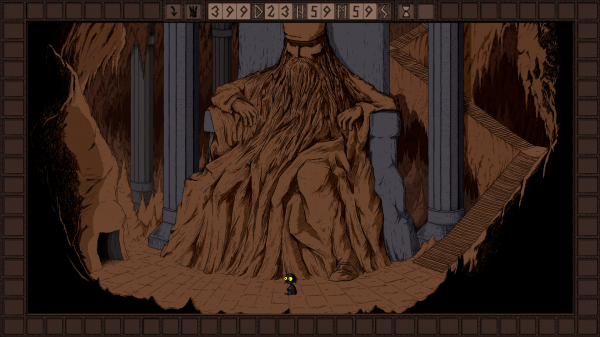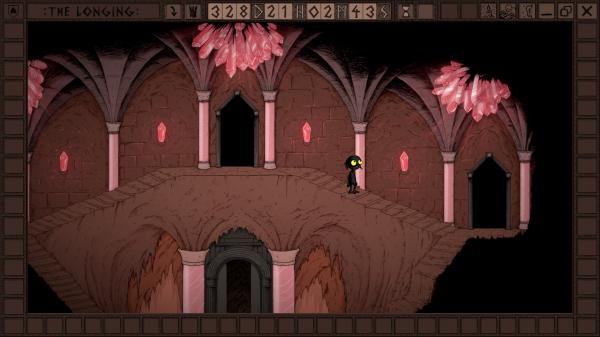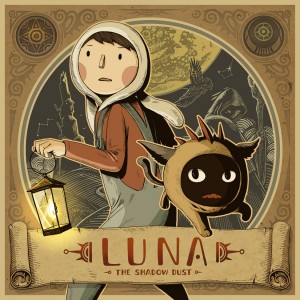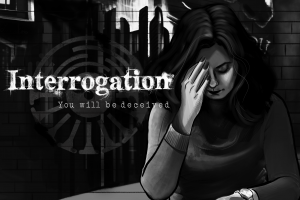The Longing in progress archived preview
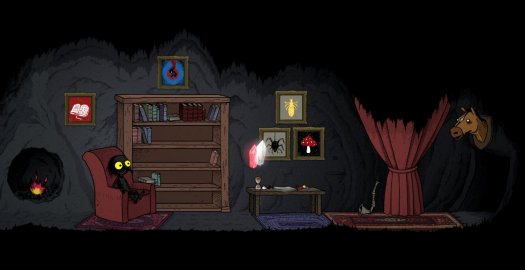
The Longing tells a simple story: you are a Shade, the lone remaining subject of a weary king whose power is almost spent. With the last of his energy, your liege tasks you to keep watch over his underground realm while he retreats into a four-hundred-day slumber to recover his strength. Once he’s asleep the game begins, and you’ll receive no further instruction from there on what you should do or how to do it: so long as you stay within the bounds of the king’s domain and are there to wake him when the time expires, your time is yours to do with what you will. You’ll have a great deal of it, too, as the game unfolds in real time, with the clock counting down the seconds, minutes, hours and days even after you’ve logged off. It’s down to you to decide what to see and do; the king’s realm is vast, with many secrets to be uncovered, and nothing—save the exit—is explicitly off limits.
When I volunteered for this assignment, I expected to focus mostly on The Longing’s real-time mechanic and to experience what it was like to play a game that could run for more than a year. A game about waiting—whose central mission was simply to stave off loneliness and ennui while anticipating the eventual passage of time—seemed like a unique idea that might appeal to a smaller, mostly unexplored niche of the game-playing community, and I felt it would probably require careful explanation as to how it worked and, most importantly, whether it did. After all, how many people are that interested in finding ways to survive isolation?
Well. For those future readers who are—hopefully—viewing COVID-19 in the rearview mirror, the pandemic struck early on in my playthrough of The Longing, confining me along with a large portion of the world’s populace indoors more or less indefinitely. Isolation, loneliness, and finding bright spots in darkness are, as of this writing, no longer ideas that might cause a game to be dubbed “experimental;” they’re topics we discuss daily with loved ones, neighbors, and (if we see any) total strangers. We are all more or less living as the Shade does: on our own (more or less) and unsure of ourselves as we look for ways to occupy our time in anticipation of the day when our burden and sense of responsibility will lift. On its surface, then, the present moment seems like it would be a terrible time to play The Longing, in the same way that there’s no need to boot up Madden in the middle of the Super Bowl. What I’ve found, though, is that the exact opposite is true: so far, The Longing has been a thoughtful and enchanting experience about finding things to hold onto in the dark and cold of a world in which one feels alone. If anything, the Shade’s long wait has helped me to better cope with my own.
The Longing emphasizes choice as a core mechanic in a much different way from most character-driven games. There aren’t any branching paths or either/or choices to determine where the story goes. Instead, the player is empowered to essentially determine what kind of game they want The Longing to be. You can, of course, be a good little Shade and carry out your sacred trust, finding ways to cope with the time stretching out ahead of you in advance of the king’s awakening. The Shade has a threadbare little cave to call its own, adorned with some meager shelves and a little fireplace, and if you choose you can make it your mission to turn the place into a comfortable home. There are plenty of resources and thrown-away treasures to be found in the kingdom’s many dark corners, and a number of them can be repurposed into furniture, decorations or recreational equipment.
If that’s your style, you can seek out tools to reshape your surroundings, or for ways to make your fires burn longer and warmer, or even for art supplies with which to produce wall hangings. The more cozy and homey you make your cave, the faster the timer moves while you’re inside, so that one second can become two or three; it’s thus possible to finish the game before four hundred real days have actually passed, so long as you build a nice home and let the Shade spend time there. You might want to go hunting for old books to bring back and read in your armchair; there are many of these scattered around, and for the most part they’re full-length, readable texts of public domain classics, including novels, poetry collections and philosophical treatises. It’s entirely possible to treat the game as an elaborate interactive library, spending its entire runtime acquainting yourself with Melville and Nietzsche and leaving your cave only to track down more reading material.
If being a homebody isn’t your thing, you can also explore the length and breadth of the kingdom for its own sake. Those who do will be treated to some truly breathtaking hand-drawn artwork and environmental design as you cover the great distances between points of interest. The king’s realm feels like a living place, rich with history and the character of centuries. There’s an impressive amount of variety on display for what’s essentially a series of stone caves; some stretches are dark and oppressive, while others are lit by glowing crystals or bedecked with plant and fungal life. Gray and dingy passages frequently give way to unexpected splashes of life and character. Everywhere are buttressed columns and crumbling architecture hewn from the cavern stone, a fusion of the natural and artificial that speaks to the central conflict of endurance versus entropy. The king himself, whose vast slumbering form you must walk past when traveling to or from your cave, appears to have merged with the landscape, his stony crown reaching up to join with the stalactites above him.
The vast majority of the story is told through the environment, with very little exposition, so it’s left to you to decide the significance of the details for yourself. What subjects walked these halls and grottoes before you? Where did they go? Who carved out these caverns, and why—have there been other kings before this one, or is he the first? And why, when he seems so far beyond earthly concerns, does the king keep treasure piled behind a sturdy crystal pane? The Shade doesn’t know, and we may never find out either. Part of the joy is simply in the wondering.
Reportedly the game has several endings, not all of which require waiting out the clock. The Shade is vaguely aware of an exit to the kingdom that lies somewhere far above, and comments in subdued tones about what it might take to reach it. Can you find it and leave for the outside world, or did the king anticipate rebellion and put something in place to stop you? As with so much else, I currently have no idea. If you want to try to find out, the game will let you; if not, you don’t need to give it a second thought. (You might also wonder whether you could set your computer’s date and time forward and skip right to the end. All I’ll say on the subject is that no one can stop you from trying…)
After loneliness, size seems to be The Longing’s chiefest concern. The kingdom is huge, and traveling from point A to point B requires seeing every inch of the terrain along the way. The Shade’s flat-footed shuffle is the only speed available, and as there’s no fast travel option it can take several minutes to walk from one corner of the realm to another. The interface is one-button point-and-click; a single click causes the Shade to take one step forward, while double-clicking somewhere will make it walk to that spot and holding the mouse button down will cause it to walk continuously toward the cursor as the screen scrolls. There’s no readily available map, but the drop-down menu will let you “remember” a location as a snapshot which you can then select to start the Shade walking back there, though you’re only allowed a certain number of remembered locations before you’ll have to start overwriting. (There’s also at least one secret hidden away in the tunnels that can help you get your bearings, but you’ll have to find it on your own.)
With all the time you’ll spend in the Shade’s company, you’ll gradually gain insight into its situation and its way of thinking; lacking anyone else to keep it company, it frequently speaks its sorrows, hopes and dreams aloud. Sometimes it will gently hint at things to look out for in your travels, but more often it will simply provide melancholy musings on its lot in life. Once in a while it will question itself about its own feelings or what it should do next, and you’ll be prompted to select one of several replies; it’s still unclear to me at this point whether your input in these “conversations” actually changes anything or if the sequences are just there to help you focus on how you want to play. Speech is unvoiced, popping up in rectangular boxes with the speaker’s face displayed beside it and your available replies (if there are any) appearing below.
The soundtrack helps to bring the game’s sense of scale forward, with a synth-organ aesthetic that creates an atmosphere of almost religious reverence. In some areas it’s backed by faint chanting reminiscent of a requiem mass, while in others it sinks to a low, funerary hum. The word epic has been overused to the point of near-meaninglessness by now, but here it’s really the only word that fits: the sweeping, orchestral-sounding instrumentals convey nothing so much as the feeling of size, perfectly complementing the cavernous, cathedralesque halls of the king’s court and the endless waiting darkness of the adjacent tunnels. With the Shade’s tiny footsteps echoing just beneath it, the music is a constant reminder of how small you are in relation to the world around you, and the various tracks emphasize the simultaneous wonder, melancholy and terror accompanying such awareness.
Puzzles are mostly simple; many involve kickstarting processes that will change your environment and allow you access to new areas. You can climb and manipulate features like moss, stones and cobwebs to cross gaps or ascend rock faces—when the Shade comes alongside a hotspot, a clickable prompt appears telling you what you can do—but sometimes you’ll come to an area that’s presently impassable. Frequently you’ll have to move or place something there that you found elsewhere, so that it can grow larger over time or otherwise alter its surroundings into a more maneuverable layout. (There’s no manageable inventory; when the Shade finds an object it will either show back up in your cave or be kept in reserve to be brought out in an appropriate spot). Usually the Shade will tell you how long you have to wait for a given process to finish; I’m currently waiting for a month to elapse so I can cross a slowly filling pool of water.
The Shade and I still have around two hundred days left in front of us. I don’t know what we’ll discover in that time or how the game world will change; the same, of course, is true of the world we live in. For both the Shade and my sheltered-at-home self, the changes we’ve set in place in the king’s realm have provided some much needed chronological goalposts for us to move toward. The finish lines of our respective waits might seem like forever from now, but contrasted against that, the two weeks it takes to grow a fresh tuffet of moss to climb feels like no time at all—and when it’s elapsed, we’ll be two weeks closer to getting out than we were before.
The Shade began with four hundred days ahead of it; that much time or more may have passed for the rest of us before this pandemic and the resultant quarantine restrictions are over. But we move forward, one tiny increment at a time, always with our eyes on that distant moment when the timer at last ticks over to zero and we can enjoy whatever freedom will look like, as whatever people we might have become by then. If you’re reading this at the time of publication and you want to know how the full game measures up to these initial positive impressions: stay safe, stay home, and in two hundred days or so you’ll find out. I’ll do the same, because I want to be the one to tell you. Mark it on your calendar, if you’d like, as I’ve done with several of the Shade’s obstacles—each day is another day closer to knowing for sure. For those of you future readers, coming to this article in a time when both The Longing and the coronavirus are remembered as artifacts from the past—wherever, whenever, whoever you are—congratulations on making it through.


